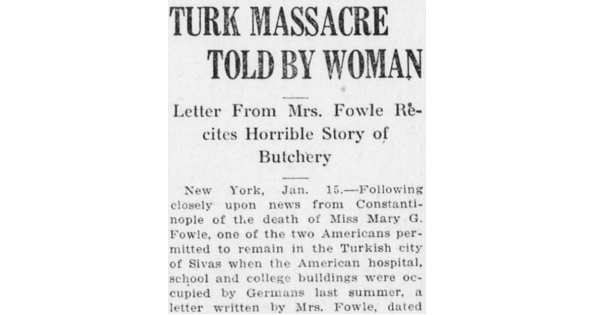
TURK MASSACRE TOLD BY WOMAN
Letter From Mrs. Fowle Recites Horrible Story of Butchery
Harrisburg Telegraph,
January 18, 1917.
New York, Jan. 15. - Following
closely upon news from Constanti-
nople of the death of Miss Mary G.
Fowle, one of the two Americans per-
mitted to remain in the Turkish city
of Sivas when the American hospital,
school and college buildings were oc-
cupied by Germans last summer, a
letter written by Mrs. Fowle, dated
July 7, has just been received here.
The letter recites in detail a vivid tale
of massacre in the interior of Turkey
when men and women persisted in
maintaining their religious beliefs and
refused to change their names.
On Monday, June 26, the letter says,
all the native laborers who had been
working on the roads were taken into
custody. On the following day more
than 3,000 men were crowded into a
military prison, without food or
water. Later some 200 artisans and
servants were released upon condition
that they change their names. Press-
ure was brought to bear upon others
and continued for ten days, until the
majority of the prisoners yielded.
Prisoners brought to the military
prison from villages, the letter set
forth, had no changes of clothing.
Miss Fowle and her only American
companion, Miss Mary L. Graham,
aided these unfortunates as best they
could. Later the prisoners were sent
to Bozanti on the German railroad.
The letter continues:
"The prisoners went off in groups
of 200 to 300 per day. When the first
group started off in daylight, with only
a few escorts, we felt reassured. By
Sunday 1,000 had gone. Early Thurs-
day morning came reports that all
who left Sivas had been massacred.
We did not believe it at first. We
have now seen one eyewitness who
escaped and two others who had
heard this news with but one inter-
mediary. We all feel convinced now
that there have been massacres.
"The men were apparently taken
out two by two and delivered into the
hands of villagers armed with axes,
pikes, saws and other weapons. Our
second account said the prisoners
were stood up, bound and shot. Our
informant managed to roll into a gully
and escape, although he was shot at.
He reported seeing half-burned arms
and legs and heads in the gully as he
passed through.
"Now when prisoners ask us
whether to change their names or be
sent off we don't dare say no."
Chronicling America: Historic American Newspapers. Lib. of Congress.
Further Reading:
Miss Mary Carolyn Fowle (U.S Missionary)



